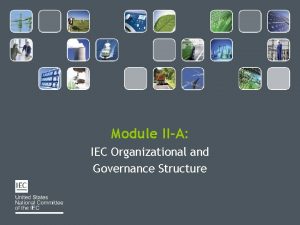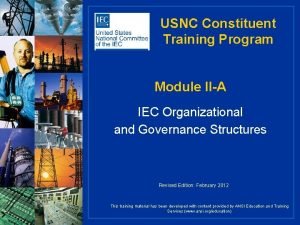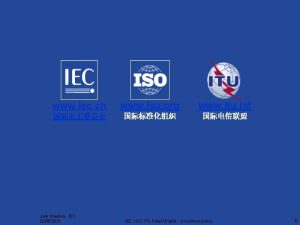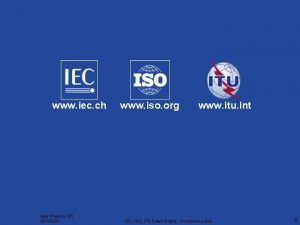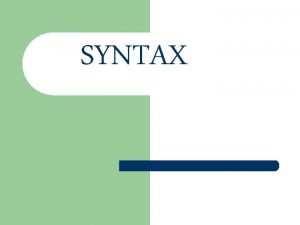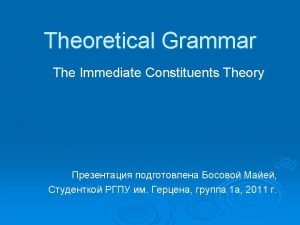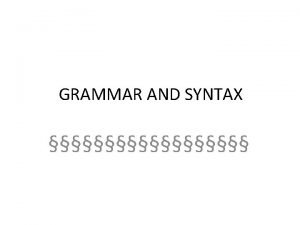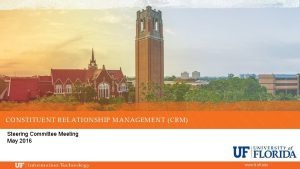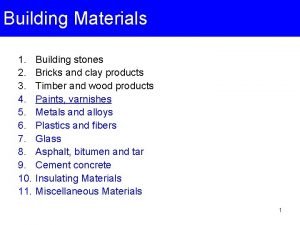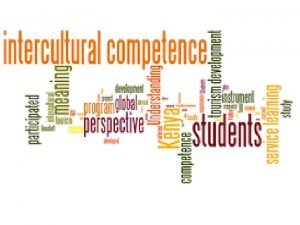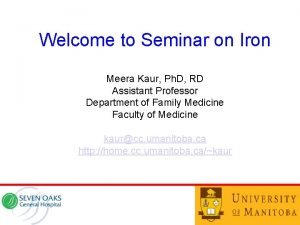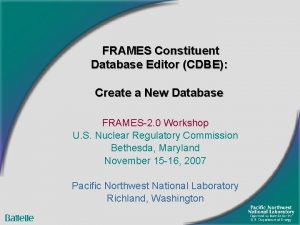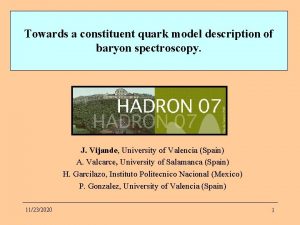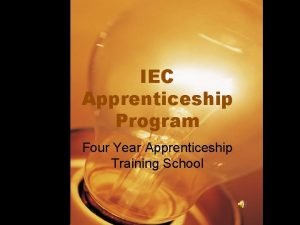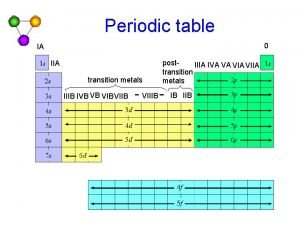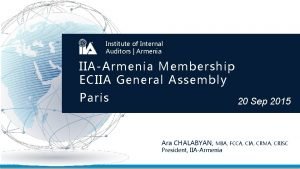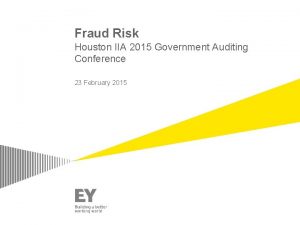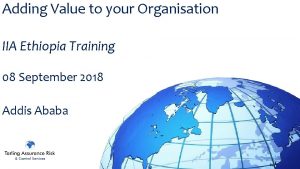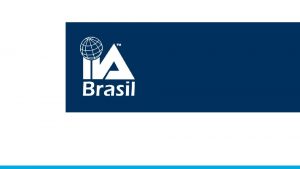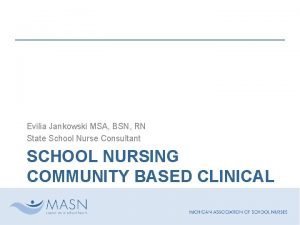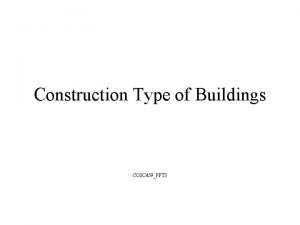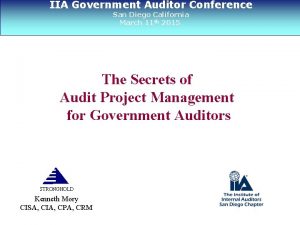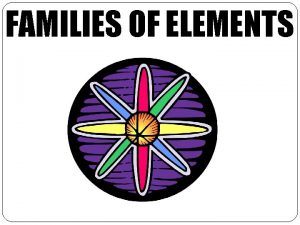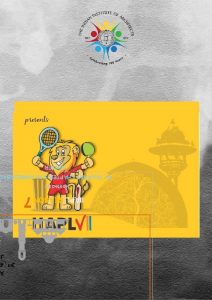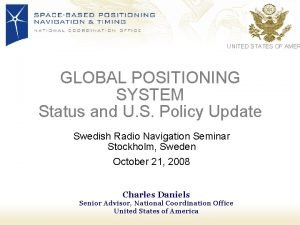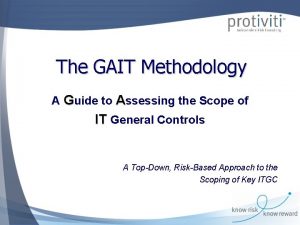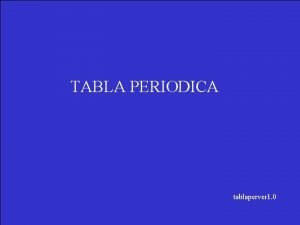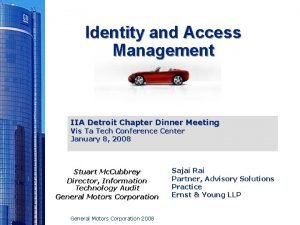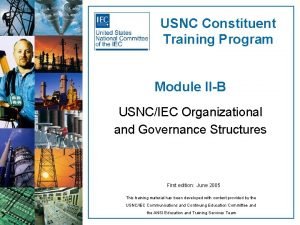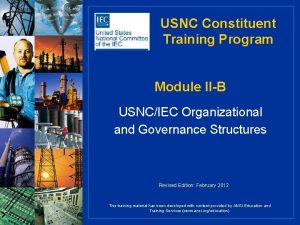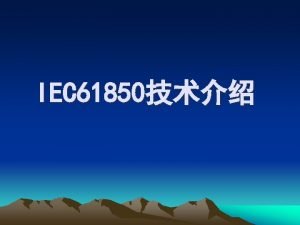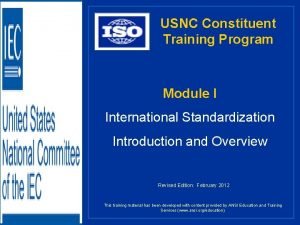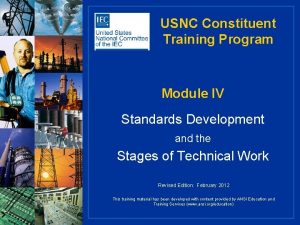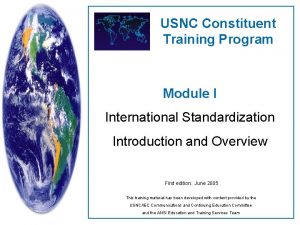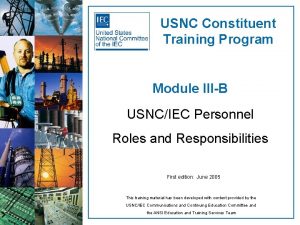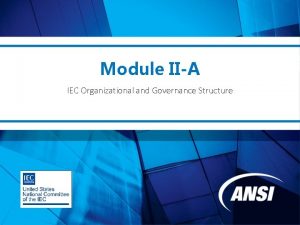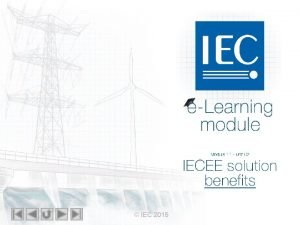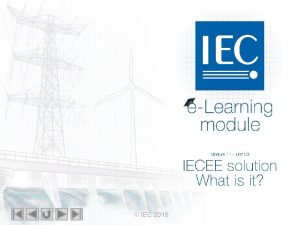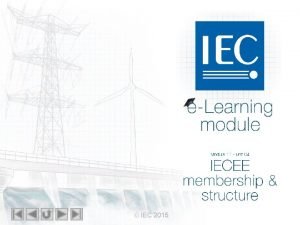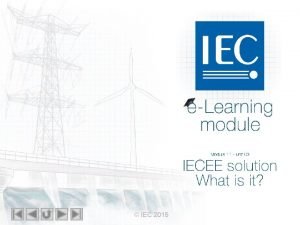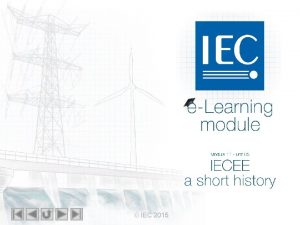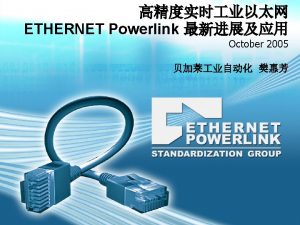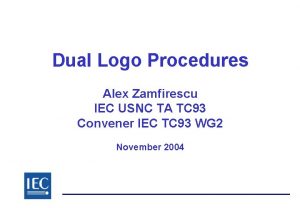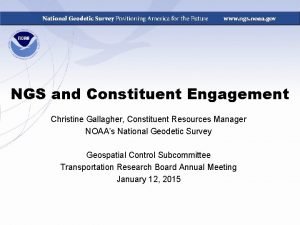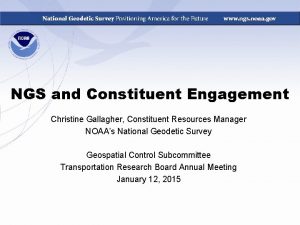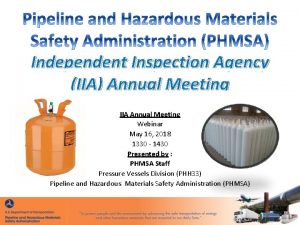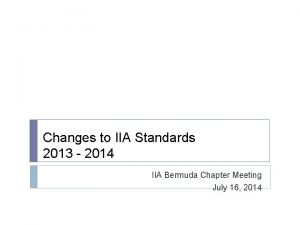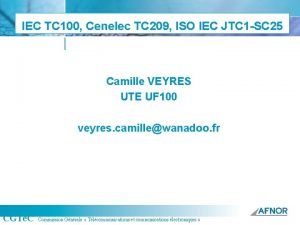USNC Constituent Training Program Module IIA IEC Organizational
































- Slides: 32

USNC Constituent Training Program Module II-A IEC Organizational and Governance Structures Revised Edition: February 2012 This training material has been developed with content provided by ANSI Education and Training Services (www. ansi. org/education)

Module II-A: Learning Objectives n This module provides an overview of the International Electrotechnical Commission: n Membership n Policy and management groups Technical committee structure n Liaison categories n

Module II-A: Disclaimer n The information contained in this self-taught learning module is intended as a summary of documents and procedures frequently used within the IEC and the USNC/IEC n The topics that follow are presented in summary only. For additional information about content addressed in this module, please contact the USNC/IEC staff n Additional information is also available via ANSI Education and Training Services

Reference Materials & Source Documents n n n n ISO/IEC Directives, Part 1: 2011 Procedures for the technical work ISO/IEC Directives, Part 2: 2011 Rules for the structure and drafting of International Standards ISO/IEC Directives, IEC Supplement 2011 Procedures specific to IEC Statutes and Rules of Procedures IEC membership and participation procedures USNC Statutes and Rules of Procedure Model Operating Procedures for USNC/IEC TAGS Guide for U. S. Delegates to meetings of ISO and the IEC

Objectives of the IEC n Meet the requirements of the global market efficiently n Ensure primacy and maximum world-wide use of its standards and conformity assessment schemes n Assess and improve the quality of products and services covered by its standards n Establish the conditions for the interoperability of complex systems n Increase the efficiency of industrial processes n Contribute to the improvement of human health and safety n Contribute to the protection of the environment

IEC Organizational Structure

Dues and Budget n IEC derives its income from: n annual dues paid by its members n the sale of publications n other sources (as approved by the Council)

Dues and Budget n The Council determines the annual budget, including the annual dues of its members, which are divided as: n Group A: Those NCs that pays the highest fixed percentage of the total dues n The remainder from all other Full Member National Committees

IEC Membership and Participants n National Committees (NC) n n A National Committee (NC) is an IEC member body Each NC represents a nation's electrotechnical interests in IEC management and standardization work NC’s are comprised of private and public sector organizations Membership structure: n Full Member NC – full participation rights n Associate Member NC – limited participation n Affiliates – nonmembers with limited access to resources

Rights of IEC National Committees Full Member Associate Member Vote on all TC/SC and Council documents via electronic voting system Authorized to submit votes on documents of 4 selected TC/SCs via electronic voting system No voting rights Comment on all TC/SC and Council documents Authorized to submit comments only on TC/SC documents but not on the Council documents Authorized to submit comments on the documents of 10 selected TC/SC by e-mail LIMITED PARTICIPATION RIGHTS NOT A MEMBERSHIP ACCESS TO INFORMATION ONLY FULL PARTICIPATION RIGHTS Affiliate

National Committee Participation - TCs and SCs n National committees have the right to participate in the work of every IEC TC and SC*. They may register as either a Participating (P) or an Observer (O) Member. All Members should: n Organize efficient and timely votes and comments on all matters coming before the committee(s) in which they participate n n Take into account all relevant interests at their national level Provide input at the earliest possible time so as to mitigate duplication, overlap and redundancy *Associate members may participate, under certain conditions, in a limited number of committees

National Committee Participation - TCs and SCs Participating “P” Members n Responsible for submitting votes and/or comments on all technical matters coming before the committee n n Votes are submitted within the given timeframe. Failing to vote on questions before the committee will be reported by the Secretariat to the IEC Office. Send delegation or accredited experts to meetings n Failing to make a contribution to two (2) consecutive meetings, either by direct participation or by correspondence, will be reported by the Secretariat to the IEC Office n Nominates members on Project Team (PTs), Working Groups (WGs), Maintenance Teams (MTs) n May host meetings of the committee

National Committee Participation - TCs and SCs Observer “O” Members n Monitor the technical work, but do not actively participate n n n * Have options to attend meetings and to receive and comment on documents Have no power of vote within the committee* May not nominate members in PTs, WGs, MTs All national bodies, regardless of their status within a particular technical committee or subcommittee, have the right to vote on enquiry drafts and on final draft International Standards (see Module 4 for additional information)

National Committee Participation - IEC Council n n Sets IEC policy, long-term strategic and financial objectives Members are the Presidents of all National Committees of the IEC, past presidents, IEC officers, CB members Approves financial matters, IEC membership, revisions of Statutes and Rules of Procedures Elects IEC officers and members of Council Board (CB), Standards Management Board (SMB), and Conformity Assessment Board (CAB)

IEC Council Board (CB) Works for the good of the whole Commission and its constituency n n n Implements the IEC Council policy and makes policy recommendations Comprised of IEC Officers and 15 voting members elected by Council CB reports all of its decisions to Council

IEC Council Board (CB) Members are elected on their professional qualifications n Some permanent elected members are appointed from those National Committees in financial Group A n The other individual members are from the Full Member National Committees

Conformity Assessment Board The Conformity Assessment Board (CAB) is responsible for the overall management of the IEC’s conformity assessment activities n Comprised of a Chairman, 12 voting members (and alternates) who are elected by Council, one representative from each IEC conformity assessment scheme, the IEC Treasurer and General Secretary n It reports all its decisions to the Council Board

Conformity Assessment Board Responsible for evaluating and maintaining, as necessary, the IEC conformity assessment systems n IECEE - System for Conformity Testing and Certification of Electrical Equipment n IECQ-CECC - System for Quality Assessment of Electronic Components and Associated Materials and Processes. n IECEx - System for Certification to Standards for Safety of Electrical Equipment for Explosive Atmospheres.

Standardization Management Board (SMB) n n n Manages the technical work through TC/SC reports/Strategic Policy Statement (SPS) and data prepared by IEC Central Office (CO) Reviews the functioning of TC/SCs and proposed changes Approves nominations for Chairpersons and Secretariats of TCs and SCs Creates/disbands new TCs, ratifies creation/disbanding of new SCs Develops rules for standards development process n ISO/IEC Directives and the IEC Supplement Reports to the Council Board

Standardization Management Board (SMB) n Responsible for management of the activities of the IEC Technical Committees n Oversees operation of Advisory committees n n n Electricity transmission and distribution (ACTAD) Infrastructure of telecommunications networks (ACTEL) Safety (ACOS) Electromagnetic compatibility (ACEC) Environmental aspects (ACEA)

Standardization Management Board (SMB) n Comprised of 15 members n n n Chairman Elected by Council Secretariat held by the IEC Central Office (CO) USNC is one of the permanent members of the SMB n Meets 3 times a year n Documents, comments and votes normally handled electronically n Decisions require a two-thirds majority of those members voting; if less than eight members vote, the decision must be deferred to the next meeting of the SMB

Marketing Strategy Board (MSB) n n n Comprised of 15 members Reports to the IEC Council Board Identifies the main technological trends and market needs in the IEC's fields of activity Sets strategies to maximize input from primary markets and establishes priorities for the technical and conformity assessment work of the IEC Helps establish the Commission's response to the needs of innovative and fast-moving markets

Marketing Strategy Board (MSB) The MSB meets at least once a year n It is composed of: n A chairperson n 15 high level technology expert members appointed from industry n IEC Officers n The U. S. has four representatives on the MSB n

IEC Standards Development n The primary duty of an IEC Technical Committee (TC) or Subcommittee (SC) is to develop and maintain International Standards and other alternative deliverables n Projects must fall within the overall area of work of the committee and: n n n must be defined and accepted in accordance with relevant procedures must be managed through a defined process in accordance with strict target dates are often sub-assigned to Working Groups for development or maintenance

Technical Committees (TC) Responsible for conducting technical work of IEC n Formed when new area of technical work is identified and if. . . n n n at least two thirds majority of the IEC national committee submitting votes in favor at least five IEC national committees express their intention to actively participate Established (including title and scope) by the Standardization Management Board n Title and Scope determined by SMB

Technical Committees (TC) Examples of the most recently established IEC TCs TC 113 - Nanotechnology standardization for electrical and electronic products and systems TC 114 - Marine energy - Wave, tidal and other water current converters TC 115 - High Voltage Direct Current (HVDC) Transmission for DC voltages above 100 k. V TC 116 - Safety of hand-held motor-operated electric tools TC 117 – Solar Thermal Electric Plants PC 118 – Smart Grid User Interface TC 119 – Printed Electronics

Subcommittees (SC) Established and dissolved by the parent TC, subject to ratification by the IEC SMB n n n Responsible for progressing the technical activities of a more narrowly defined aspect of the TC’s program of work Title and scope defined by the TC (within the scope of the TC) At least five members of the TC are willing to participate actively

Project Teams (PT), Working Groups (WG) and Maintenance Teams (MT) n Created if necessary by TC or SC for further defined focus n n n WGs are responsible for a grouping of related projects PTs are responsible for a single project MTs work on a revision project New edition n Amendment n n Conveners (i. e. the chair of the PT, WG or MT) are appointed by the parent TC or SC

IEC Standards Development n n n IEC standards development work is conducted within a technical committee structure To facilitate the most broad participation possible, most development work is undertaken “virtually” (e. g. , via e-mail correspondence, online development, videoand teleconferences, etc. ) Meetings of IEC technical committees are held only when work cannot be conducted by other means n Agenda and documents must be circulated at least four months before a meeting to allow adequate time for review by the National Committee delegates

USNC Constituent Training Program Module II-A Complete. IEC Structure

U. S. National Committee Staff Contacts n Gary Kushnier Vice President, International Policy gkushnier@ansi. org 202. 331. 3604 n n Mary Johnson IEC Voting Coordinator mjohnson@ansi. org 212. 642. 4939 n Debra Negron IEC Meeting Coordinator dnegron@ansi. org 212. 642. 4936 Tony Zertuche Program Manager and Deputy General Secretary tzertuche@ansi. org 212. 642. 4892 Kevin Sullivan USNC/IEC Department Supervisor ksullivan@ansi. org 212. 642. 4963 Charlie Zegers Senior Program Director and USNC General Secretary czegers@ansi. org 212. 642. 4965 n n n Elizabeth Pomales USNC Experts Coordinator epomales@ansi. org 212. 642. 4964

Contact Information USNC of the IEC American National Standards Institute 25 West 43 rd Street Fourth Floor New York, NY 10036 Tel: 212. 642. 4900 Fax: 212. 398. 0023 www. ansi. org/usnc | www. ansi. org | webstore. ansi. org E-Learning: Learning at your own pace in your own space
 Iec iia
Iec iia Iec iia
Iec iia Www. iso.org
Www. iso.org Iec
Iec Module 31
Module 31 Iec e-learning
Iec e-learning Iec e learning module 1
Iec e learning module 1 Syntax definition
Syntax definition Whats a morpheme
Whats a morpheme Immediate constituent analysis
Immediate constituent analysis Constituent analysis
Constituent analysis Crm constituent relationship management
Crm constituent relationship management Paint classification
Paint classification Elements of intercultural competence
Elements of intercultural competence Iron is a constituent of
Iron is a constituent of Cdbe
Cdbe Constituent quark model
Constituent quark model Iec electrician apprenticeship
Iec electrician apprenticeship Ia
Ia Iia armenia
Iia armenia Houston iia
Houston iia Iia ethiopia
Iia ethiopia Iia brasil
Iia brasil Msa health
Msa health Construction type iia
Construction type iia Iia san diego
Iia san diego Which group is alkali earth metals
Which group is alkali earth metals Iiapl
Iiapl Iia global
Iia global What is itgc
What is itgc Tabla de primera persona
Tabla de primera persona Iia detroit
Iia detroit Iia
Iia
